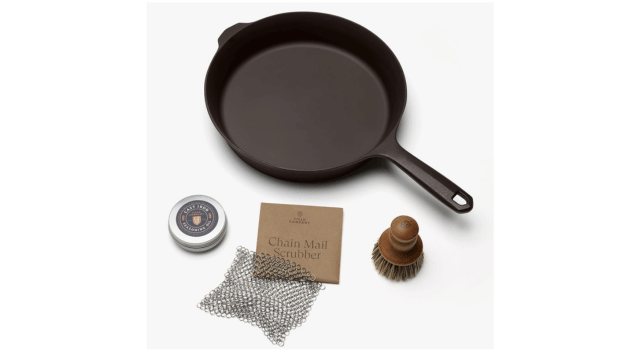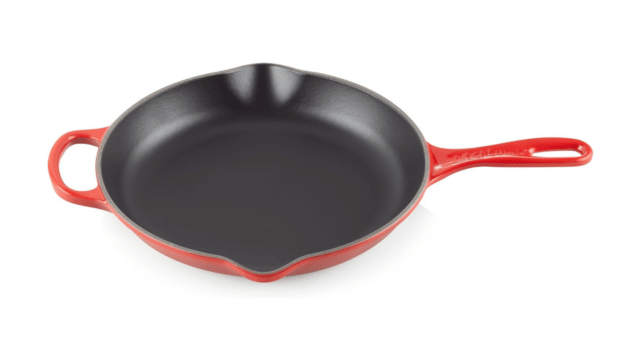A cast iron skillet brings timeless versatility to your kitchen, perfect for searing, sautéing, baking, and more. Known for its exceptional heat retention and even cooking, it transforms everyday meals into culinary experiences. From stovetop to oven, this sturdy, long-lasting cookware is ideal for everything from perfectly crisped cornbread to tender steaks. Pre-seasoned for a naturally non-stick surface, it enhances flavors over time. Whether you’re a seasoned chef or a home cook, a quality cast iron skillet is a kitchen essential that will stand the test of time.
Best Cast Iron Skillets Buying Guide
Cast iron skillets have been a staple in kitchens for centuries, and for good reason. These versatile cooking vessels offer unparalleled heat retention, durability, and the ability to develop a natural non-stick surface over time. Whether you’re a professional chef or a home cooking enthusiast, a high-quality cast iron skillet can elevate your culinary creations and become a cherished heirloom passed down through generations. This guide will help you navigate the world of cast iron skillets, ensuring you make an informed decision when adding this essential piece to your kitchen arsenal.
Key Factors to Consider When Choosing a Cast Iron Skillet
Size and Weight
The size of your cast iron skillet is a crucial consideration that depends on your cooking needs and preferences. Cast iron skillets typically range from 6 inches to 15 inches in diameter. A 10 to 12-inch skillet is often considered the most versatile size for most home cooks, capable of handling everything from a single fried egg to a family-sized cornbread. Smaller skillets (6 to 8 inches) are ideal for individual servings or side dishes, while larger ones (13 to 15 inches) are perfect for big families or when entertaining guests. Remember that cast iron is inherently heavy, and larger skillets can be quite cumbersome to maneuver. Consider your physical strength and comfort when choosing a size, as the weight increases significantly with diameter. Some cooks prefer to have multiple sizes to cater to different cooking scenarios.
Pre-seasoned vs. Unseasoned
Cast iron skillets are available in both pre-seasoned and unseasoned varieties. Pre-seasoned skillets have already undergone the initial seasoning process, which involves coating the pan with oil and baking it to create a protective layer. This makes them ready to use right out of the box and provides a good starting point for building up your own seasoning over time. Unseasoned skillets, on the other hand, require you to season them before first use. While this takes more initial effort, some cooks prefer the control it gives them over the seasoning process. Both types will develop an increasingly non-stick surface with proper care and regular use. If you’re new to cast iron cooking, a pre-seasoned skillet might be the more convenient option, but seasoning a pan yourself can be a rewarding experience for those who enjoy the process of caring for their cookware.
Handle Design and Ergonomics
The handle of your cast iron skillet plays a significant role in its usability and comfort. Traditional designs feature a single long handle, which provides good leverage for lifting and maneuvering the pan. Some skillets come with a helper handle on the opposite side, which can be invaluable for safely lifting heavier or larger skillets. Consider the length and shape of the main handle – a longer handle provides more leverage but can make storage tricky, while a shorter handle might be more compact but offer less control. The thickness and ergonomics of the handle are also important for comfort during use. Some handles come with a silicone or heat-resistant covering for easier handling, though these may limit the skillet’s oven-safe temperature range. Ultimately, the best handle design depends on your personal preference and cooking style.
Cooking Surface and Pour Spouts
The cooking surface of a cast iron skillet can vary in terms of texture and design. Some skillets have a smooth, polished surface, while others have a slightly textured finish. A smoother surface can be easier to develop a non-stick seasoning on, but both types will perform well with proper care. Pay attention to the depth of the skillet – a deeper pan is better for dishes with more liquid or for frying, while a shallower one might be preferable for tasks like searing or making pancakes. Many cast iron skillets feature pour spouts on one or both sides, which can be helpful for draining excess fat or transferring dishes. The effectiveness of these spouts can vary, so consider reading user reviews to gauge their functionality if this feature is important to you.
Versatility and Oven Compatibility
One of the greatest advantages of cast iron skillets is their versatility. They can transition seamlessly from stovetop to oven, making them ideal for recipes that require both cooking methods. When choosing a skillet, consider its oven-safe temperature rating. Most cast iron skillets can withstand very high temperatures, often up to 500°F (260°C) or more. However, if the skillet has any wooden or plastic components, this may limit its oven-safe temperature. Additionally, think about the types of cooking you plan to do. Some skillets come with lids, which can be useful for braising or keeping food warm. Others might have special features like grill ridges on the bottom, which can add versatility to your cooking options.
Care and Maintenance Requirements
Caring for a cast iron skillet requires a bit more attention than other types of cookware, but the rewards are well worth the effort. Consider your willingness to follow proper care instructions when choosing a skillet. All cast iron requires seasoning maintenance, which involves regularly coating it with oil and heating it to maintain its non-stick properties and prevent rust. Some skillets may come with specific care instructions or recommendations for the best oils to use. Think about how much time you’re willing to invest in caring for your skillet. While the process becomes quicker and easier with practice, it’s an ongoing commitment. Also, consider storage – cast iron needs to be stored in a dry place to prevent rusting, and some cooks prefer to hang their skillets to save cabinet space and showcase their cookware.
Conclusion: Investing in a Lifetime of Culinary Excellence
Choosing the right cast iron skillet is an investment in your culinary future. By carefully considering factors such as size, weight, seasoning, handle design, cooking surface, versatility, and maintenance requirements, you can select a skillet that will meet your needs and become a treasured kitchen companion for years to come. Remember that cast iron cookware improves with age and use, developing a unique seasoning that enhances its cooking performance and adds character to your meals. Whether you’re searing steaks, baking cornbread, or crafting the perfect frittata, a well-chosen cast iron skillet will be your go-to pan for a wide range of cooking tasks. Take the time to research and, if possible, handle different skillets before making your decision. With proper care and use, your cast iron skillet will not only elevate your cooking but also become a beloved heirloom that can be passed down through generations, carrying with it the flavors and memories of countless meals shared with family and friends.










